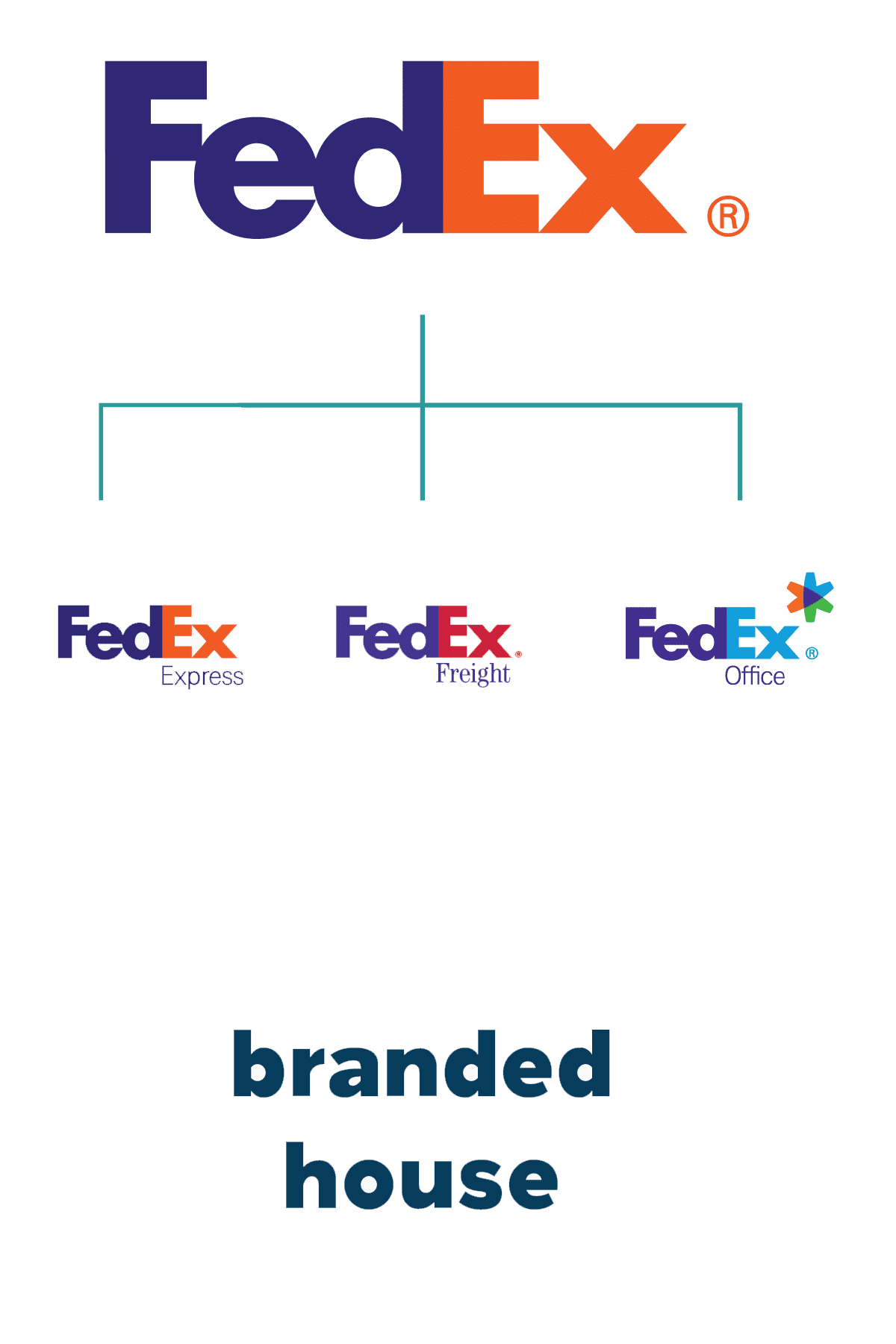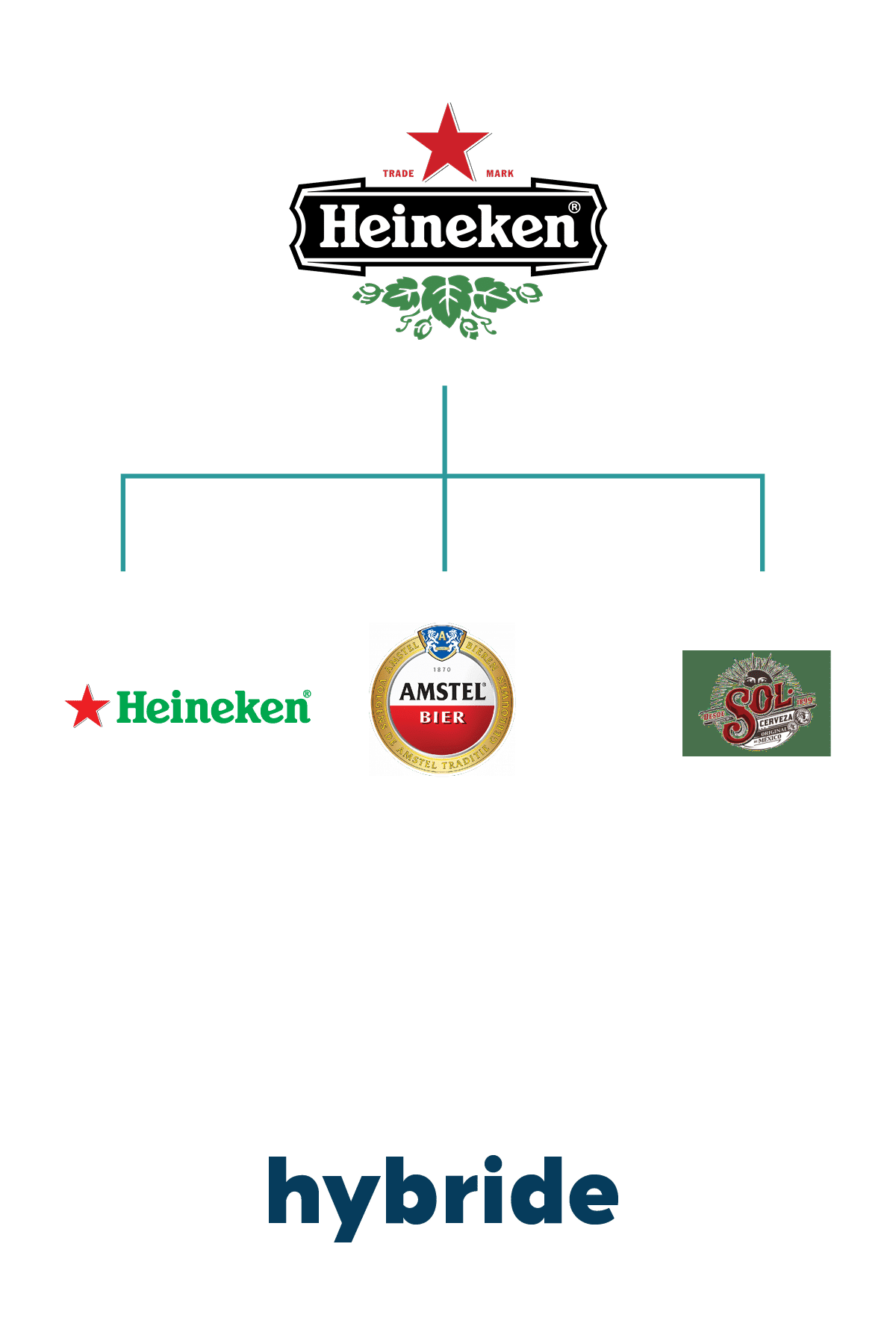*Positioning
A practical look at brand hierarchy strategy and brand architecture.

How to identify brand positioning opportunities before your competitors do? And how to give your new brand a higher chance of success? Brand architecture and brand hierarchy are strategic activities that can make or break your success. In this article, we look at the main types of brand architecture and examine the brand architecture of Unilever and Heineken. After reading this article, you will know which brand architecture and strategy best fit your organization.
Every company with multiple brands – a brand portfolio – automatically has a brand architecture or brand hierarchy. But is this the result of a clear strategy?
Many marketers only think about their brand architecture during major changes such as mergers, acquisitions, launches or rebrands. They are forced to review the whole situation. Suddenly problems arise that were invisible for a long time, such as poor reputations, cannibalization or disappointing growth compared to the market average. How can you prevent this?
Brand Hierarchy
A clear brand hierarchy ensures that your company optimally uses its brand portfolio to achieve its objectives. If one brand with a number of variants is active in different categories within the same market, the brand hierarchy, for example, tells you how these brands relate to each other and reinforce each other. But you can also introduce a different brand for each market or category, as Unilever has shown with great success.
 Unilever Brand Architecture
Unilever Brand Architecture
The brand architecture of the Dutch/British FMCG giant Unilever consists of about 400 different brands that stand alone in their conscious category or market. The combined revenue of these brands is around 50 billion euros, of which 13 individual brands are responsible for more than 1 billion euros in revenue. This type of brand architecture is called a House of Brands. Why? We will explain that later in this article.
Definition of Brand Architecture
Brand architecture is the structure of brands within one organizational entity and the way in which brands in the company’s portfolio are connected or distinguished from each other.
Brand architecture ensures that customers can easily see how certain brands are connected, or not, and makes it easy for them to find what they are looking for. For one company, this means that one brand name appears on all services, while for another, each brand stands alone in the conscious category or market. These are all conscious choices made based on strategy. But what types are there?
Brand hierarchy types

The most commonly used types of brand hierarchy come from Aaker and Joachimsthaler’s Brand Relationship Spectrum, which are:
- Branded House
- Sub-brands
- Endorsed Brands
- House of Brands
- Hybrid
This last type, Hybrid, was added later because companies increasingly used a mixed brand hierarchy due to mergers and increasing globalization. Brand hierarchy is therefore clearly a spectrum of possibilities from which companies can choose. We will discuss the advantages and disadvantages of each type separately.
Branded House Brand Architecture
 In a Branded House, there is a main brand that acts as an umbrella over a wide range of products, possibly spread across multiple categories and markets. A well-known example is the transporter FedEx, which became a huge name in the transport world and always puts its one brand first.
In a Branded House, there is a main brand that acts as an umbrella over a wide range of products, possibly spread across multiple categories and markets. A well-known example is the transporter FedEx, which became a huge name in the transport world and always puts its one brand first.
Advantages of Branded House brand structure
This structure provides a consistent brand experience that minimizes any confusion for your customers. You can use synergy and scale advantages between activities, which allows you to work on your brand value simultaneously in individual markets and for the overall brand.
Disadvantages of Branded House brand architecture
At the same time, there is also a real risk that a scandal or other failure in one market will have a negative effect on activities in other markets. This can be political in nature, as we saw with Chinese electronics manufacturers, but it can also be due to PR factors, such as the emergence of a report on child labor at one of the suppliers. This last example caused Nike to lose revenue on all fronts, not just its shoe division.
Monolithic brand strategy
In Dutch, the Branded House approach is also called a monolithic brand strategy because there is one brand that stands out in all respects (revenue, name recognition, reputation) above many individual brands. Think, for example, of Samsung, that brand not only stands for electronics and appliances but is also one of the world’s largest shipbuilders and life insurers.
Sub-brands brand architecture
In the use of sub-brands, the main brand is also the most important element, but it is possible to add other associations to it. Sony was known for its Walkman and televisions but was able to attract a large number of new fans with the PlayStation brand. Richard Branson’s Virgin also has a wide variety of Virgin brands, from mobile phones to space travel, and makes maximum use of its name recognition.
Advantages of sub-brands brand structure
It is perhaps the best of both worlds. You use this structure to quickly gain credibility and name recognition in certain markets or categories, but also have the freedom to load this new brand in its own way. So it is an ideal way to explore new markets without risking too much damage to the main brand.
Disadvantages of sub-brands brand architecture
The biggest disadvantage is that a sub-brand stays very close to the main brand and therefore has difficulty with values or associations that are far from it. A very reliable brand will have difficulty establishing an experimental image under one of the sub-brands, for example. And a brand like Nivea – which is very much focused on softness – may have difficulty bringing a razor to the market.
Endorsed Brands brand architecture
Endorsed brands have a unique name but use elements of the main brand, for example, as a subtle quality guarantee. A well-known way is the so-called token endorser, where an element of the main brand reappears in a subtle place on the product, for example. But a connection in terms of name is also possible, Nestlé has, for example, Nespresso, Nestea, and Nescafé as endorsed brands. Finally, there are also unspoken connections to be made, Lexus is unmistakably a Toyota brand, although this fact is not emphasized anywhere.
Advantages of Endorsed Brands brand architecture
With Endorsed Brands, you get even more flexibility than with sub-brands, and whether this is desirable depends, of course, on the market. The further apart the categories or markets are, the more value an endorsed brand has for a main brand. It can give a more unique connotation and associations while still somewhat leveraging the brand awareness of the main brand.
Disadvantages of Endorsed Brands brand architecture
And that latter point is also the main disadvantage; there is less synergy and economies of scale than with the first two examples. An Endorsed Brand requires a completely different approach and investment, and therefore it is often a costly venture if success is uncertain.
House of Brands brand architecture
 The fourth and originally last type of brand architecture is the House of Brands, where each brand is an independent, standalone brand. The most famous example of this is of course Unilever, which, with its various brands, belongs to the absolute top in many markets. The positioning of Dove, Magnum, and Lipton is unique and has nothing to do with each other, but each of the brands has a leading market share. Unilever is organized in such a way that these brands, within certain frameworks, can do exactly what they want.
The fourth and originally last type of brand architecture is the House of Brands, where each brand is an independent, standalone brand. The most famous example of this is of course Unilever, which, with its various brands, belongs to the absolute top in many markets. The positioning of Dove, Magnum, and Lipton is unique and has nothing to do with each other, but each of the brands has a leading market share. Unilever is organized in such a way that these brands, within certain frameworks, can do exactly what they want.
Advantages of House of Brands brand architecture
The American P&G is the counterpart of Unilever and realized in the 1950s that their traditional organizational structure caused many of their brands to underperform. By subsequently reorganizing as a House of Brands, many of these brands recovered and became profitable. The company has followed a clear brand strategy since then, sometimes even successfully having multiple brands in one market. The success of P&G led to Unilever embracing this approach.
Disadvantages of House of Brands brand architecture
In the case of a House of Brands, there is of course very limited synergy and economies of scale. There may still be some overlap in the procurement of advertising space and back-office services, but the unique brands likely also require a completely different approach here. It is costly, but worth it if a brand can acquire a significant market share in an important market as a result
Hybrid brand architecture
In practice, almost all large companies have a mixed strategy. Through mergers, acquisitions or unexpected growth, a brand architecture arises that may be monolithic but may also include an endorsed brand in some cases. This is called a hybrid brand architecture. Depending on the balance you choose, the above advantages and disadvantages also apply to the hybrid brand architecture
 Heineken Brand Architecture
Heineken Brand Architecture
The brand architecture of Heineken is a hybrid brand architecture. The main brand Heineken is not only the company name, but of course also appears on the world’s most famous beer. There are a number of variants that fall under the same brand – Extra Cold, club bottle and the portable keg – but the most important are the regular beer and the 0.0 variant. But in addition, the company also carries Amstel, Brand, Affligem, Desperados, Wieckse and Sol. With a total of 400 brands, Heineken is one of the largest beer brewers in the world.
Choosing the right brand architecture strategy
Based on the advantages and disadvantages of each of the four types described above, you can find the brand architecture that best suits your organization and portfolio. At the same time, companies need to realize that a brand architecture is not a static concept. By continuously assessing whether your brand architecture still serves your goals, you keep it sharp. This ensures that you have a better chance of:
- Identifying opportunities for brand positioning before your competitors do
- Avoiding the high costs of rebranding or shutting down brands
- Launching new brands that will survive longer
- Discovering new markets and/or target groups more quickly
- Maintaining long-term brand consistency and building stronger brands
- Feeling more confident about your strategic brand choices
 Heineken Brand Architecture
Heineken Brand Architecture